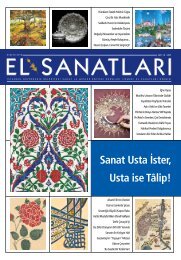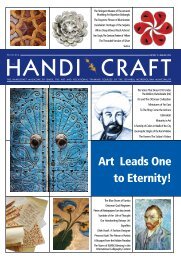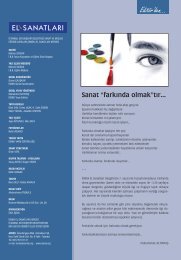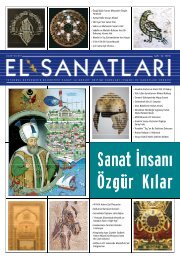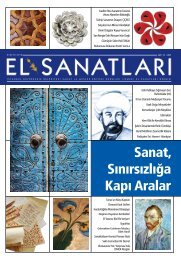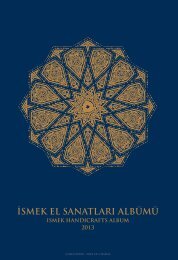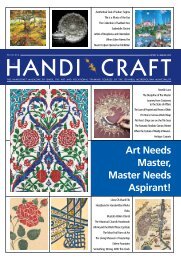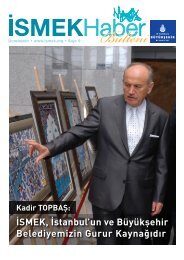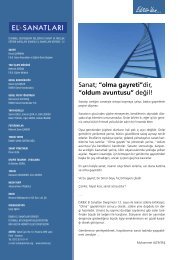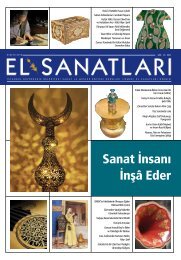Download Link - Ä°SMEK
Download Link - Ä°SMEK
Download Link - Ä°SMEK
You also want an ePaper? Increase the reach of your titles
YUMPU automatically turns print PDFs into web optimized ePapers that Google loves.
many more countries, the reed has become ney at this<br />
stage and there will be no further processes. But, Turkish<br />
culture and aesthetics add a piece called ‘parazvane’ to<br />
ney. Actually parazvane is made up of two pieces, two<br />
bracelets added to each end of the ney. The parazvane<br />
has function in addition to its aesthetic appeal. It protects<br />
the ney from cracking and from shocks. It is especially preferred<br />
in Anatolia. It’s sure that Suleyman Erguner was using<br />
the most aesthetic parazvane.<br />
He says, “I used to make the parazvane myself, but now<br />
my friend who makes ‘başpare’ makes them.” Then he<br />
starts to tell about the importance of parazvane and how<br />
they are made. “A metallic ribbon is joined by a thin layer<br />
of weld and polished lightly. I use silver, usually German<br />
silver. Or, I buy silver from Grand Bazaar. Silver is used in<br />
sections in touch with the mouth, so what’s the difference<br />
from a spoon Some people use brass or even plastics,<br />
but it isn’t nice in visual terms and it doesn’t leave a good<br />
taste in the mouth.”<br />
The Favorite Part of Ney is Başpare<br />
Parazvane is not the only addition that Anatolian aesthetics<br />
concerns have added to ney. Another accessory<br />
not found in any other country, but Turkiye is Başpare.<br />
“I use ‘başpare’s made of water buffalo horns, both on<br />
my own neys and on the neys I’ve made for my students.<br />
Why water buffalos Because the most aesthetic<br />
and the most qualified ones are made of them. I have a<br />
handyman Bulent Usta in kapalıçarşı (closed bazaar), who<br />
makes my ‘başpare’s. My father Ulvi Erguner taught him<br />
how to make them.” Suleyman Erguder approaches this<br />
craftsmanship with a different point of view: “My father<br />
knew well how to make başpare, but to know something<br />
doesn’t mean that it has to be your profession. Another<br />
thing is that making ‘başpare’s is a very difficult job. Water<br />
buffalo horn is much harder even harder than marble.<br />
Two knives are worn out while making out the form of<br />
başpare. Many people make their living by this job, so I<br />
don’t have to do everything by myself. I’m concerned with<br />
only the reed, I’m fond of it.”<br />
As Ney Is Blown, It Is Burnt; As It Is Burnt, It Gets Mature.<br />
When the başpare is implemented, ney is now ready to be<br />
blown. As it is blown it is burnt. As it is blown, it becomes<br />
a little darker, a maturity in the ney is observed. “Neys<br />
from especially Hatay region burn as they are blown and<br />
they give out a deeper and a more mature sound.” says<br />
Suleyman Erguner and shows us two of his trust neys.<br />
One of them belongs to Kazasker (a military judge) Mustafa<br />
Izzet Efendi. It has passed from hand to hand for one<br />
hundred fifty years, and we wonder whose breaths it has<br />
witnessed. On one of its nodes, it is inscribed: “Ya Hazreti<br />
Mevlana” (Oh, mighty Mevlana). The other ney belongs<br />
to grandfather Suleyman Erguner. It has passed on to the<br />
father Ulvi Erguner, and from him, to the grandson Suleyman<br />
Erguder... He blows a piece for us. He blows as if<br />
he is blowing the ancient Kazasker’s breath. We wonder<br />
how these neys have stayed so intact after so much time<br />
has passed through them. He invites us beside the pool of<br />
almond oil at one part of his workshop and keeps telling.<br />
Mutual Service Praised<br />
“In order to have a long life, the ney wants to be served<br />
because it serves human being”, says he and continues,<br />
“For their maintenance, almond oil is used.” When the<br />
time for their maintenance comes, I put them in this pool<br />
and let them stay there one or two days. When I take them<br />
out of the pool, I put them perpendicularly in a container. I<br />
put them in oil once a month in summer because they get<br />
dried up more quickly in hot weather. If they get dried up,<br />
they get cracks. But, you shouldn’t keep them too long in<br />
oil because they should not absorb the oil too much.<br />
He is continuing to perform music with self-produced<br />
handmade neys, accompanied by his students at his<br />
workshop at Çamlıca. He is not satisfied with only this<br />
occupation, He is continuing the ney performances on<br />
Tuesdays, an inheritance from his grandfather. There is no<br />
exaggeration in saying that he is ‘opening’ the ney with<br />
one hand, and he is blowing ney, with the other.<br />
153



